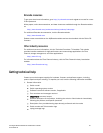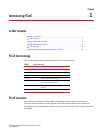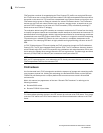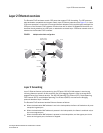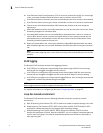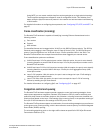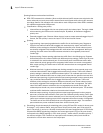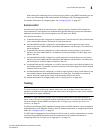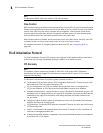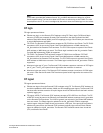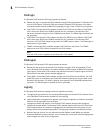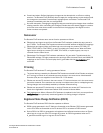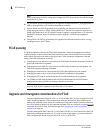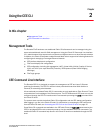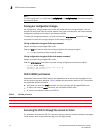
Converged Enhanced Ethernet Administrator’s Guide 7
53-1002163-02
Layer 2 Ethernet overview
1
DRAFT: BROCADE CONFIDENTIAL
When setting the scheduling policy, each priority group that is using DWRR scheduling can be
set to use a percentage of the total bandwidth by setting the PG_Percentage parameter.
For detailed information on configuring QoS, see “Configuring QoS” on page 107.
Access control
Access Control Lists (ACLs) are used for Layer 2 switching security. Standard ACLs inspect the
source address for the inbound ports. Extended ACLs provide filtering by source and destination
addresses and protocol. ACLs can be applied to the CEE ports or to VLANs.
ACLs function as follows:
• A standard Ethernet ACL configured on a physical port is used to permit or deny frames based
on the source MAC address. The default is to permit all frames.
• An extended Ethernet ACL configured on a physical port is used to permit or deny frames
based on the source MAC address, destination MAC address, and EtherType. The default is to
permit all frames.
• A standard Ethernet ACL configured on a LAG virtual port is used to permit or deny frames
based on the source MAC address. The default is to permit all frames. LAG ACLs apply to all
ports in the LAG.
• An extended Ethernet ACL configured on a LAG virtual port is used to permit or deny frames
based on the source MAC address, destination MAC address, and EtherType. The default is to
permit all frames. LAG ACLs apply to all ports in the LAG.
• A standard Ethernet ACL configured on a VLAN is used to permit or deny frames based on the
source MAC address. The default is to permit all frames. VLAN ACLs apply to the Switch Vertical
Interface (SVI) for the VLAN.
• An extended Ethernet ACL configured on a VLAN is used to permit or deny frames based on the
source MAC address, destination MAC address, and EtherType. The default is to permit all
frames. VLAN ACLs apply to the Switch Vertical Interface (SVI) for the VLAN.
For detailed information on configuring ACLs, see “Configuring ACLs” on page 101.
Trunking
NOTE
The term “trunking” in an Ethernet network refers to the use of multiple network links (ports) in
parallel to increase the link speed beyond the limits of any one single link or port, and to increase
the redundancy for higher availability.
802.1ab Link Layer Discovery Protocol (LLDP) is used to detect links to connected switches or
hosts. Trunks can then be configured between an adjacent switch or host and the Brocade FCoE
hardware using the VLAN classifier commands. See “Configuring an interface port as a trunk
interface” on page 50.
The Data Center Bridging (DCB) Capability Exchange Protocol (DCBX) extension is used to identify a
CEE-capable port on an adjacent switch or host. For detailed information on configuring LLDP and
DCBX, see “Configuring LLDP” on page 87.
The 802.3ad Link Aggregation Control Protocol (LACP) is used to combine multiple links to create a
trunk with the combined bandwidth of all the individual links. For detailed information on
configuring LACP, see “Configuring Link Aggregation” on page 79.



